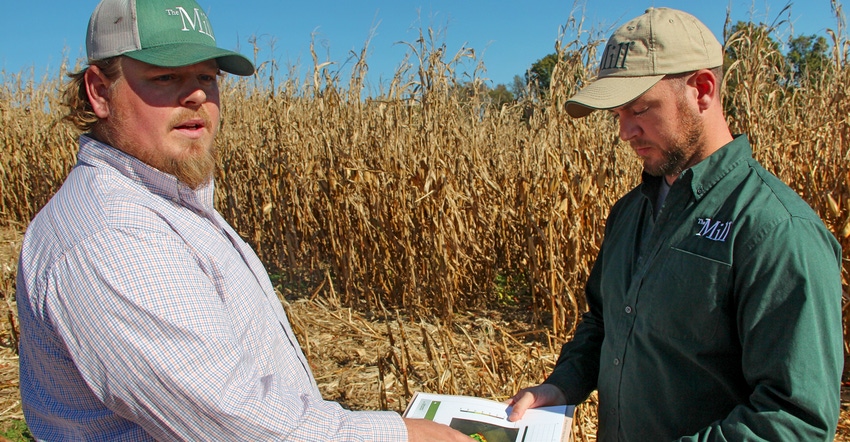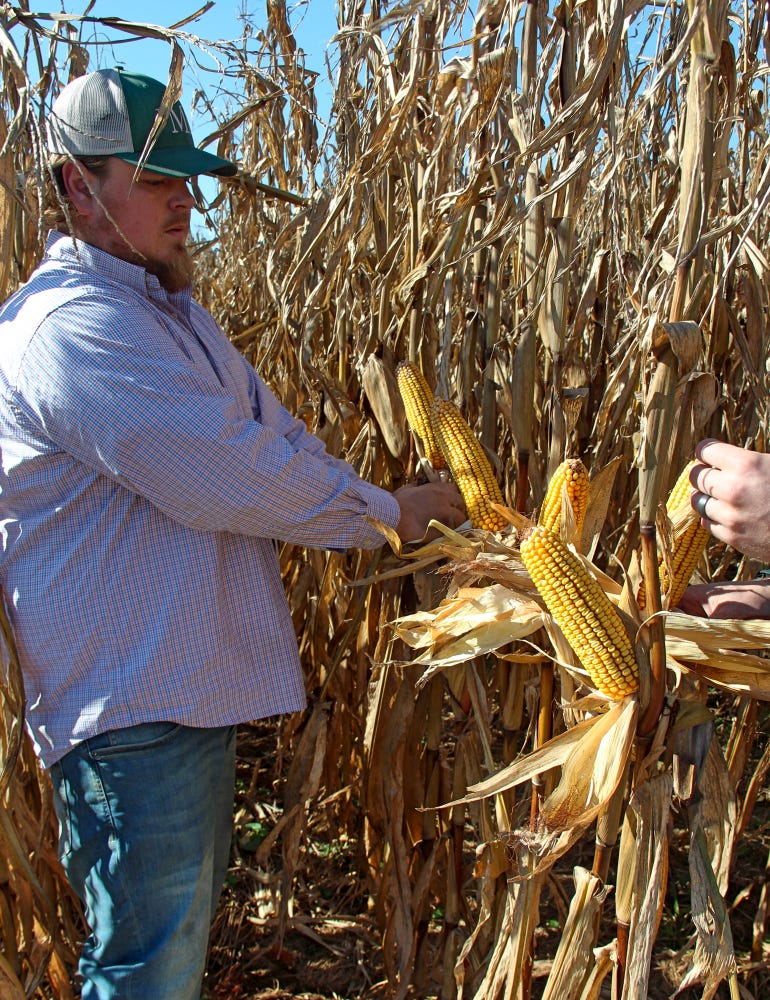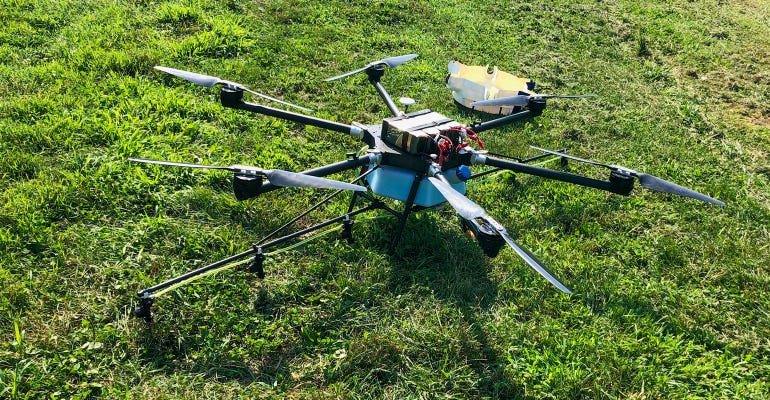
For Mike Kurek it’s pretty simple: Farming has to make money.
“I've been broke, I've had to go borrow money. It's not what I want to do. I want to farm and have fun doing it, and be efficient doing it," he says.
And he’s willing to put his money where his mouth is. In the 12 years since taking over the family farm, Susquehanna Orchards, the 34-year-old from Delta, Pa., has planted new ground, bought new equipment and invested in new technology, all with the goal of producing more and using less inputs.
“I don't want to just go out there and do what my father did or do what my grandfather did,” he says. “Not that they did anything wrong, but I want to be better, I want to smarter.”
Kurek and his wife, Patricia, and his brother manage the 320-acre operation with more than 100 acres in tree fruit, 200 acres of field crops and an on-site store.
It’s a challenge juggling multiple things, but it’s been a challenge for Kurek ever since he took the family farm from his mother.
He attended college at Thaddeus Stevens College of Technology and Millersville University, earning extra money for school by helping out on weekends and working on the farm during summers.
When his mother decided that she wanted to pursue her lifelong passion for music and no longer wanted to manage the operation, he came back and took over the farm.
It was a baptism by fire.
“I kind of learned by my mistakes, watched what other people were doing; tried to mimic it a little bit,” he says.
Focus on 4Rs
One of the first things he did was re-establish the farm’s field crops.
When he took over the farm in the late 2000s, all the corn and soybean ground was leased to a neighboring farmer. But with $7.50 corn at the time and his own equipment, he figured that he could make more money farming his own ground.
“I actually had no clue what I was doing, and I think that actually made me like a better farmer,” he says. “I read everything I could read. I didn’t have … my dad or grandfather saying, ‘well, we always did it this way, this is what you need to do.’”
He initially planted 10 acres of field crops. Within a couple of years, more than 200 acres were planted in corn and soybeans.
In many ways having the orchard business, which had already been established, helped him with his corn and soybeans.
In the orchards he focused on better use of fertilizers and other nutrients. He implemented a foliar fertilizer program and minimized soil disturbance. He also started doing tissue sampling to see what nutrients were needed at the right times.
He established his own 4Rs for his orchards, focusing on the right roots and varieties, the right spacing and using the right structures for his apples and peaches.
“It's very important because no matter how much fertilizer, no matter how much chemicals we use, if we don't get that (plantings) right to begin with, we're kind of just wasting our time," he says.
Most of new plantings, for instance, are on trellises, something he thinks is better for managing the crop.
He found that he made lots of passes in the orchard; between 20 and 25 in apples, and 18 or so passes in his peaches once a week from April to harvest. Once he started seeing the benefits of spoon-feeding nutrients in his orchards, he started doing the same for his field crops.
The first couple of years he spread 150 units of nitrogen fertilizer at the beginning of the season in his corn. Now he does split nitrogen applications and spoon-feeds the crop, sustaining it with foliar applications throughout the season. Kurek prefers foliar over broadcast fertilizer as he doesn't think broadcasting is accurate enough.
In soybeans he's trying to get away from dry fertilizer and going to foliar-applied only. He says that he ran through his soybeans four times this year.
Challenging expectations
Kurek remembers being told by his neighbor farmer, the one who rented his ground, to not expect corn yields above 160 bushels. Most of the ground he farms is covered in woods and is close to the Susquehanna River. It’s also steep in some places and very rocky.
“When you’re pulling the planter you can hear you’re hitting rocks and stuff,” he says.
As his orchards come first they are located on higher ground in better soils. The corn and soybeans are in valleys closer to the river.
But as his crop yields have improved, so have his expectations. He no longer aims for just 160 bushels, he aims for 250 bushels.
 GOOD RESULTS: Kurek’s corn yielded an average 200 bushels an acre in 2019. He challenged expectations from other farmers who told him to not expect much more than 160 bushels on his rocky, sloped farmland.
GOOD RESULTS: Kurek’s corn yielded an average 200 bushels an acre in 2019. He challenged expectations from other farmers who told him to not expect much more than 160 bushels on his rocky, sloped farmland.

In the past three or four years he’s averaged between 190 and 210 bushels an acre. He gives much of the credit to using technology.
Using Veris and Dualem, he mapped his fields and did zone sampling to get a better understanding of variations.
He started doing variable-rate nutrient applications through working with his seed adviser, The Mill, and using the Adapt-N platform. Kurek estimates that it’s $8- to $10-an-acre cheaper to do variable-rate of phosphorus, potassium and nitrogen than just putting everything on up front.
“The savings is in the fertilizer. You’re not using as much fertilizer,” he says.
He uses Climate FieldView to keep track of his annual crop yields and where in the fields they perform best. His planter, a John Deere 7000 six-row, is equipped with Precision 20/20.
This past year he planted four different corn hybrids. He tries to use hybrids that respond well to spoon-feeding of fungicide and other nutrients. This year, his corn yield average was 200 bushels with some fields getting 240 bushels.
He’s experimented even more with his soybeans, using different planters, drills, spacings, day lengths, and doing various fungicide and insecticide applications.
It paid off in 2017 with good yields in all his fields. The next year was dreadful. He estimates that he wasted $40 an acre on nutrients as a result of the record rains in 2018. In 2019, his on-farm average was 72 bushels an acre, the highest he’s ever recorded.
Hi-tech spraying
Kurek isn’t afraid to try new things, so in 2019 he tinkered with using a drone to apply fungicide at corn tasseling.
His crop adviser, Tim Hushon, set him up with the drone. Kurek says it took two days to apply a mixed nutrient package on 50 acres of his corn.
“I didn't know what to expect. The size of the drone was big but not overwhelming,” he says. “I do truly feel that is a way that even a small farmer like me may be able to benefit. The cost of a drone versus a self-propelled sprayer, the drone might cost a third of that.”
The drone, with a small 2.5-gallon tank attached to the bottom, applied 2 to 3 acres of fungicide at a time.
“It had a boom on it, maybe 10 feet. Where we did it is where we had our highest yields,” he says.
The application fee was $10 to $12 an acre, plus cost of materials, but he thinks it paid off. Not only were yields higher, but gray leaf spot, something he battles every year, was wiped out in fields where fungicide was applied.
 DRONE CONTROL: This past summer was the first year Kurek used a drone to spray foliar fungicide on his corn. The results were impressive, he says, with higher corn yields and less pressure from gray leaf spot.
DRONE CONTROL: This past summer was the first year Kurek used a drone to spray foliar fungicide on his corn. The results were impressive, he says, with higher corn yields and less pressure from gray leaf spot.

As Kurek describes it, the drone operator used a tablet to establish different points in a field. Using those points, the operator drew directional lines for the drone to follow.
“As soon as the tank would empty the drone would shoot up in the air and come to the truck automatically,” he says.
Better yields, more efficient
Along with better yields, Kurek says he’s improved his nitrogen use efficiency to 0.82 in some fields.
It ranges between 0.82 to 1.04.
His goal is to give his crops just enough food to grow healthy and to not overfeed nutrients where the environment isn’t ideal.
“I just kind of want to be more efficient with what I’m doing,” he says. “When you’re spreading, you need to know how much it costs you. I told somebody, that’s one of the hardest checks to write. You need the seed, but the fertilizer you’re just hoping it’s going to work. I feel like the more accurate we can be with that, the better we’ll be as a grower and help our bottom line.”
His commitment to being a more efficient farmer has earned him recognition from The Fertilizer Institute. He and Hushon, his crop adviser from The Mill, are one of only five farmer-adviser pairs to be named 2020 4R Advocates. The pair will be honored at Commodity Classic in February.
It’s not cheap to use technology, but at the end of the day, Kurek wants to be at the cutting-edge of farming, even if his farm is small.
“I think as we move forward we can use technology basically like analytics in baseball — What is our best bet? That’s where our world’s going to.”
About the Author(s)
You May Also Like






